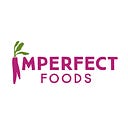Should Seaweed by the New Kale? How the Farm of the Future May be Underwater.
One of the biggest challenges to modern agriculture is how to feed a growing population with the same amount of land. One of the best ways to solve this problem may not involve the land at all. It may be to look at the other 75% of Earth’s surface in a new light. While Imperfect has historically been focused on sourcing fruits and vegetables grown on land, our work to reduce food waste has taught us that sustainability can come from some surprising and unexpected places. After reading some appetizing headlines on this subject, we knew that we had to look into it for ourselves. Here’s what we found after doing a deep dive (pun intended) into the world of sea-vegetables.
One of the first things that we learned is that growing and eating seaweed is not a new phenomenon. While it seems like another new-fangled trendy superfood, cultures around the world, from Japan to Ireland, have been eating seaweed for thousands of years, and for good reason! Seaweed is packed with vitamins, hard-to-find minerals like iodine, and a surprising amount of protein. It sounds almost too good to be true, but seaweed is a better source of protein than eggs, a better source of calcium than milk, and more vitamin C rich than oranges. Coastal cultures have also treasured seaweed for millennia because it requires no land or fresh water to grow, and it grows fast. In your kitchen, it’s also a dense source of the magical fifth flavor of umami — or savoriness. The flavor of seaweed is why dashi or miso soup broth is so satisfying to eat.
Even bigger than its unassuming health and flavor powers is the potential that seaweed has as a truly regenerative form of agriculture. After we started sourcing their delicious seaweed pasta, we had some eye-opening chats with the folks at Blue Evolution that enlightened us on the untapped potential of seaweed. Unlike land-based agriculture, which almost always involves getting rid of biodiversity for the sake of productivity, plant-based aquaculture encourages biodiversity.
We were skeptical of this claim until we heard about a pilot that Blue Evolution ran, growing sugar kelp and ribbon kelp off the coast of Alaska. They set up their test on a stretch of barren ocean, the underwater equivalent of a desert, and found that after a season, their seaweed had created a whole ecosystem around it, populated with new and happy fish, shrimp, and mollusks. In an age of climate-induced ocean acidification, the new seaweed in the area also improved the alkalinity of the water by a full point. Without using any soil, fresh water, or pesticides, they found a way to turn sunshine and seawater into a nutritious crop that was actively removing carbon from the ocean and improving biodiversity around it. While Blue Evolution and seaweed agriculture as a whole still have a long way to go to, right now we’re incredibly inspired and optimistic by this proof of concept.
Ultimately, we’re not sure if seaweed really is the new kale, simply because the more we learn about it, the more it seems to be an exciting new category of its own. The folks at Blue Evolution described it to us as the love child of kale and spirulina. We think that whatever you want to call it, we’re going to have to look at our agriculture system and oceans with a new lens of compassion, innovation, and sustainability to feed ourselves going forward. We invite you to think about how seaweed can be more than a crunchy snack or a poke bowl topping. Seaweed has the potential to be a powerful new and profoundly delicious food source that we can grow without further exhausting our soils and fresh water supply. The grass really could be greener on the other side, but in this case, that side also happens to be underwater. Are you ready to take a plunge into the new era of marine agriculture?
